The following recommended Standard Operating Procedures, together with the detailed feature documentation, are designed to give you a framework to develop your own, detailed SOPs. Links to the full documentation are throughout this document, and will open a new page. When a decision point is reached, two or more options will be offered. Click on the link that most closely describes your situation, and you will be taken to the next recommended step.
Note that in FlightSpan™ Ops there is often more than one way to complete a given step or to open a given form. To keep the SOP simple, we have limited the description to a single way of doing things. As you gain familiarity with FlightSpan™, you may find that another technique fits your workflow better.
Nature of the Flight Request
Answer each of the following questions to determine the starting point, then click on one of the links below, and you will be taken to the correct section within this document.
Decision Point
How is the flight request being made?
- Is the request being made directly? (Email / Phone Call / Walk In)
- Was the request submitted through the Flight Request Portal?
Is it a firm request (the customer will follow through with a booking), or is it a tentative request (they are just asking for a Quote)?
Based on your answers above, select the correct link to jump to the starting point:
Direct Request – Firm
Complete the Quote form and save it as a Flight Request.
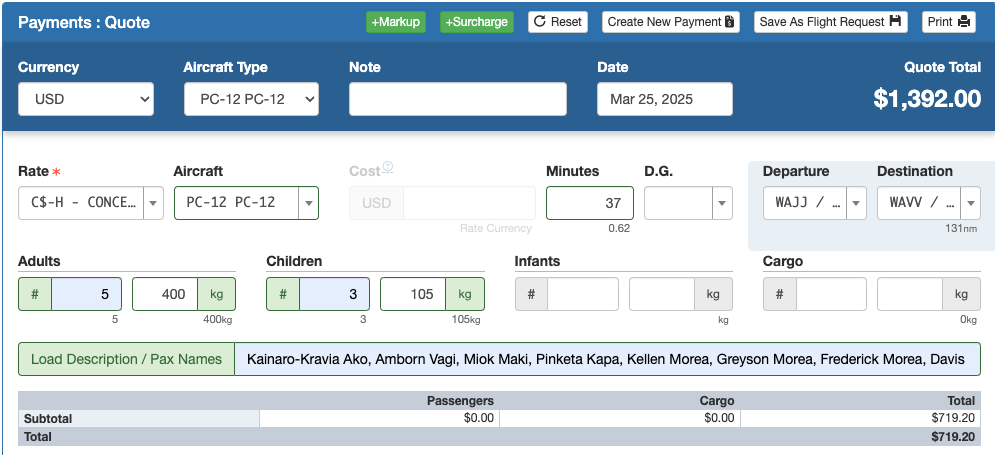
Note that the Will Not Schedule status should be used if you receive a lot of requests for quotes in comparison to the number of bookings. This will keep requests that may never be confirmed from populating the Scheduling Calendar queue.
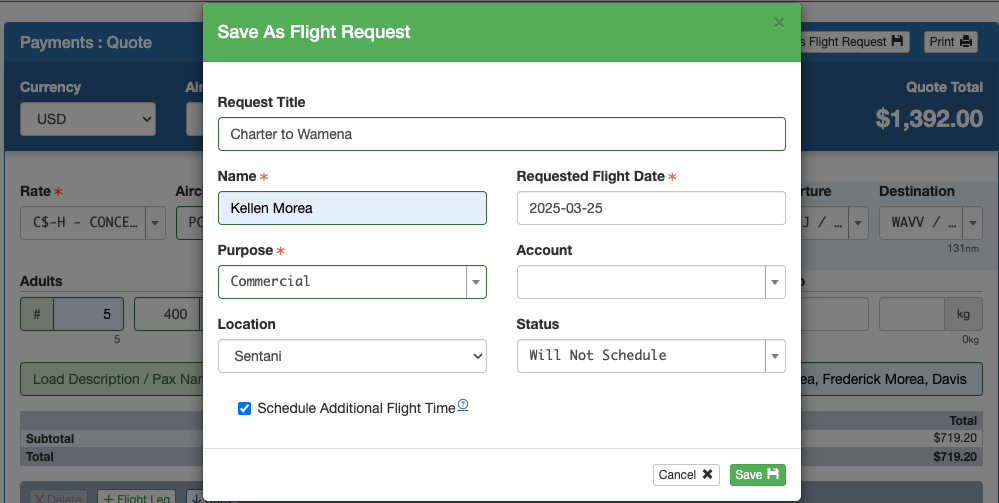
Note that the default request status can be changed from the Company Custom Settings list.

Complete the Flight Request form with any additional details.
Decision Point
Will they be paying for the flight with cash? Are they ready to pay now? Or will charges be billed to an account?
Direct Request Paid by Account
When saving the Quote as a Flight Request, include the account information.
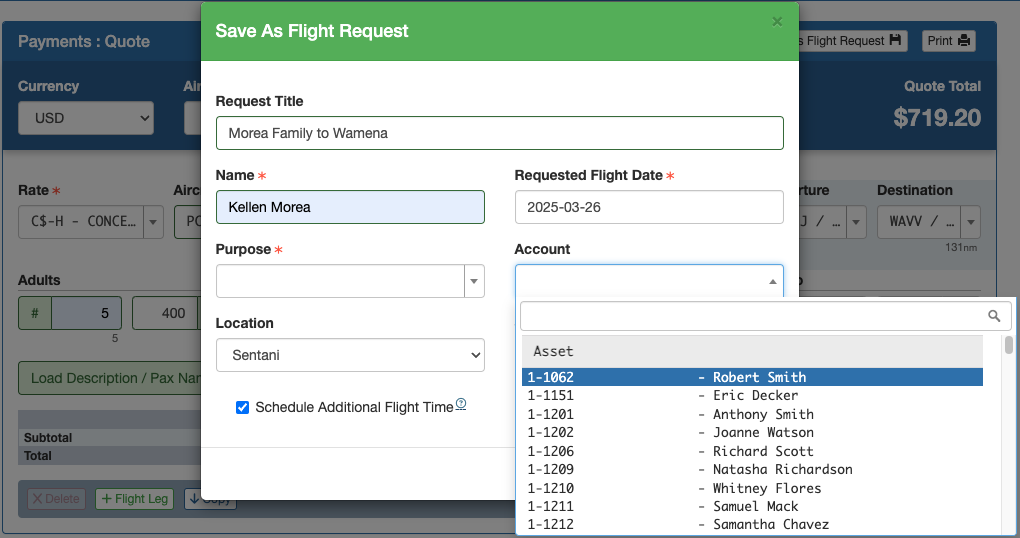
If you didn’t include the account number when you first saved the Quote as a Flight Request, select Edit, then select the account number from the dropdown list.

Next, schedule the request.
Direct Request – Tentative
Complete the Quote form and save it as a Flight Request.

Note that the Will Not Schedule status should be used if you receive a lot of requests for quotes in comparison to the number of bookings. This will keep them from populating the Scheduling Calendar queue.

The default status can be changed from the Company Custom Settings list.

From the bottom of the Flight Request, print or email the quote or pro forma invoice.

Once a tentative flight request has been confirmed, proceed to the Flight Request Confirmed section.
Flight Request Portal – Tentative
When a customer submits a flight request through the Flight Request Portal, their estimated cost is displayed on the request detail.
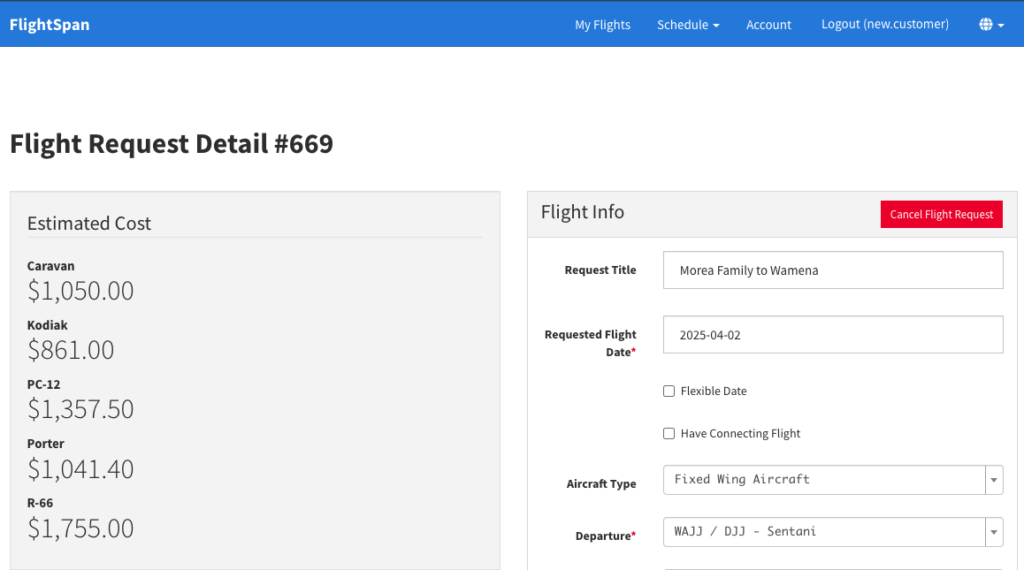
Note that if you do not wish estimated costs to show up on the Flight Request Portal, it can be switched off from Company Custom Settings.

In order to generate an official quote or a pro forma invoice, from the Flight Request List, open the request submitted through the Flight Request Portal.
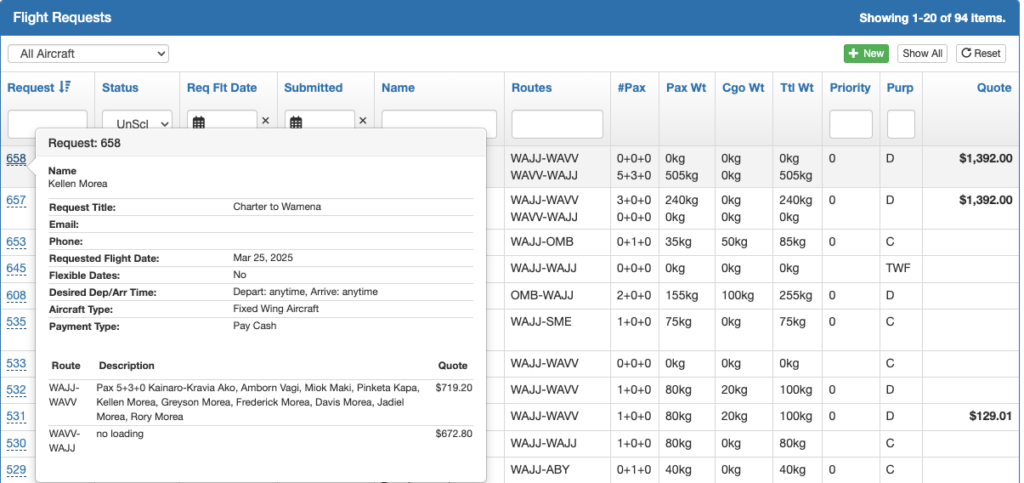
Generate a Quote using the blue button at the bottom of the Flight Request.

Then you can print or email the quote or pro forma invoice.

Once a tentative flight request has been confirmed, proceed to the Flight Request Confirmed section.
Flight Request Portal – Firm
All flight requests, including requests submitted through the Flight Request Portal can be found in the Flight Requests List.

Requests are also displayed on the Scheduling Calendar.
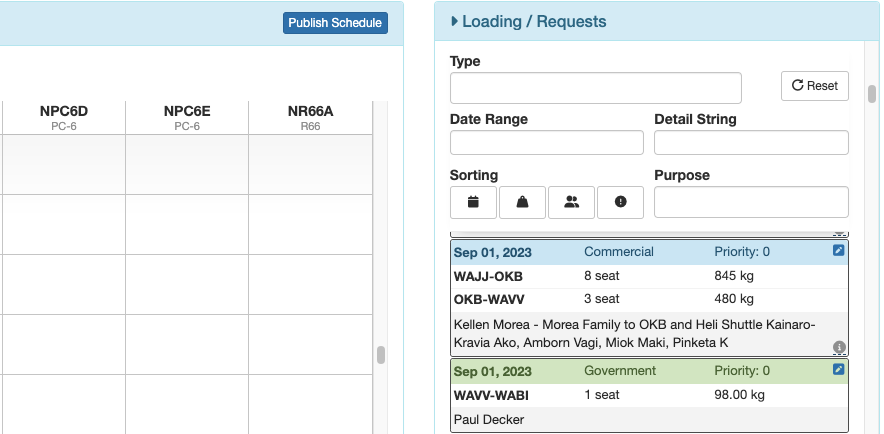
Note: Requests submitted through the Flight Request Portal have a Normal status by default.
Decision Point
Will they be paying for the flight with cash? Are they ready to pay now? Or will charges be billed to an account?
- Pay Cash Now
- Pay Cash Later
- Account (the next step is to schedule the request)
Flight Request Confirmed
Once a tentative Flight Request has been confirmed, select Edit and change the status to Normal, then Save.
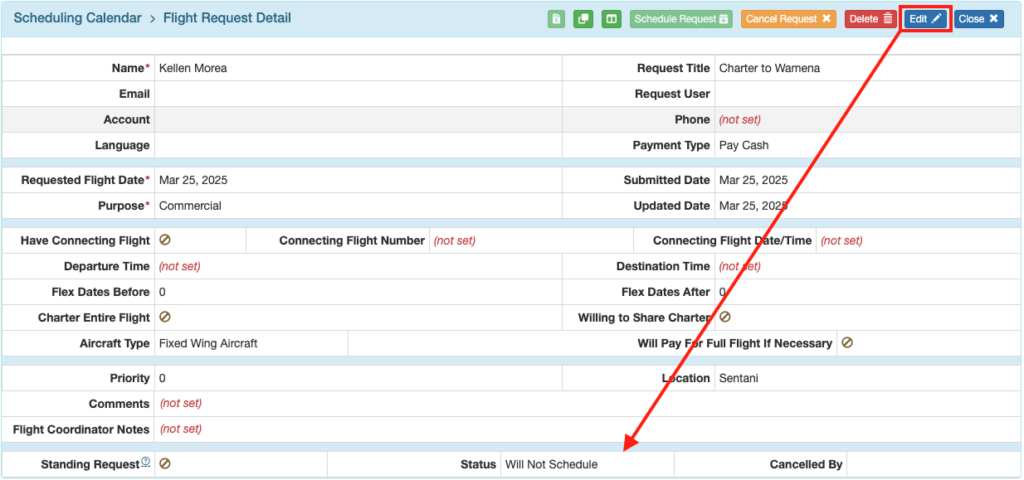
Note: Requests submitted through the Flight Request Portal have a Normal status by default.
Decision Point
Will they be paying for the flight with cash? Are they ready to pay now? Will they pay a deposit now, and the balance later? Or will charges be billed to an account?
- Pay Cash Now
- Pay Cash Later
- Account (the next step is to schedule the request)
Schedule the Request
With Account information included in the Flight Request, click the green Schedule Request button at the top. The Scheduling Calendar will open with just this Flight Request displayed.

Drag the Request onto the schedule at the desired date and time on the desired aircraft.
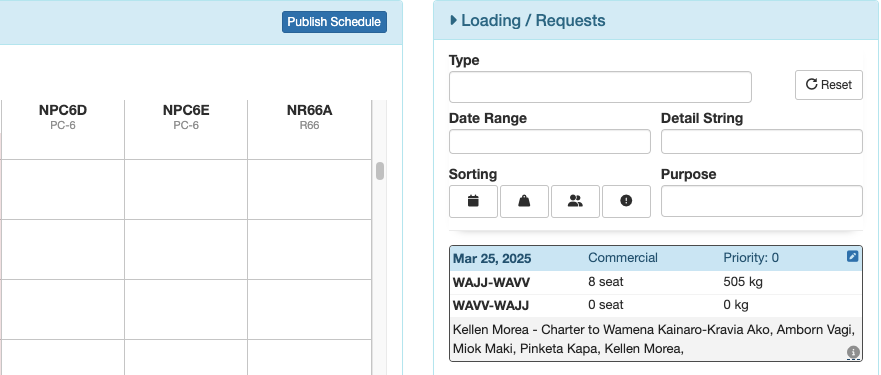
Note: A Payment for the load will be automatically created when the pilot uploads the completed flight.
Decision Point
Will you be using a Manifest for the load?
Pay Cash Later
From the Flight Request form, click the green Schedule Request button at the top. The Scheduling Calendar will open with just this Flight Request displayed.

Or from the Scheduling Calendar, search for the request among the Requests and Payments in the queue.
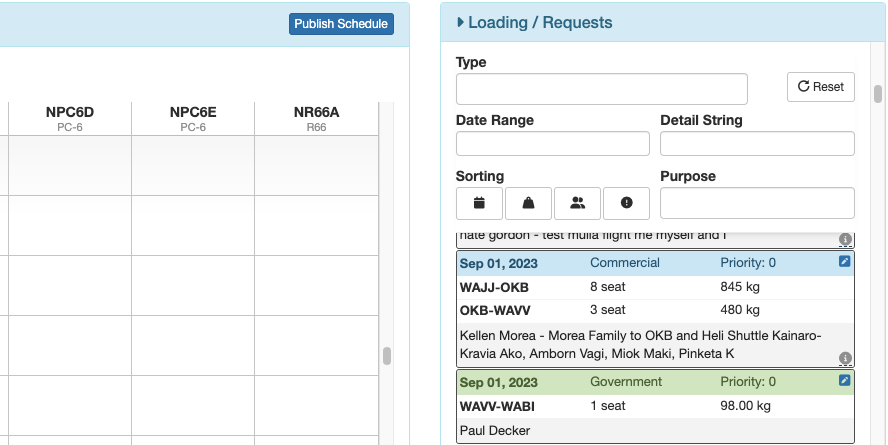
Drag the Request onto the schedule at the desired date and time on the desired aircraft.

When they are ready to pay for the flight, generate a Payment.
If it’s a single-line load, you can generate the Payment from the non-manifest load section of the Schedule Detail.

If the loading covers multiple lines (a multi-leg charter, for example) do not generate the Payment from the non-manifest load section of the Schedule Detail, since this will result in separate Payment records for each load. Instead, click on the Request icon or the Request number to open the Request Detail.

Then click the Create Payment button at the top of the Request form.

Whichever method is used, the Payment Detail will open with the appropriate data prefilled.
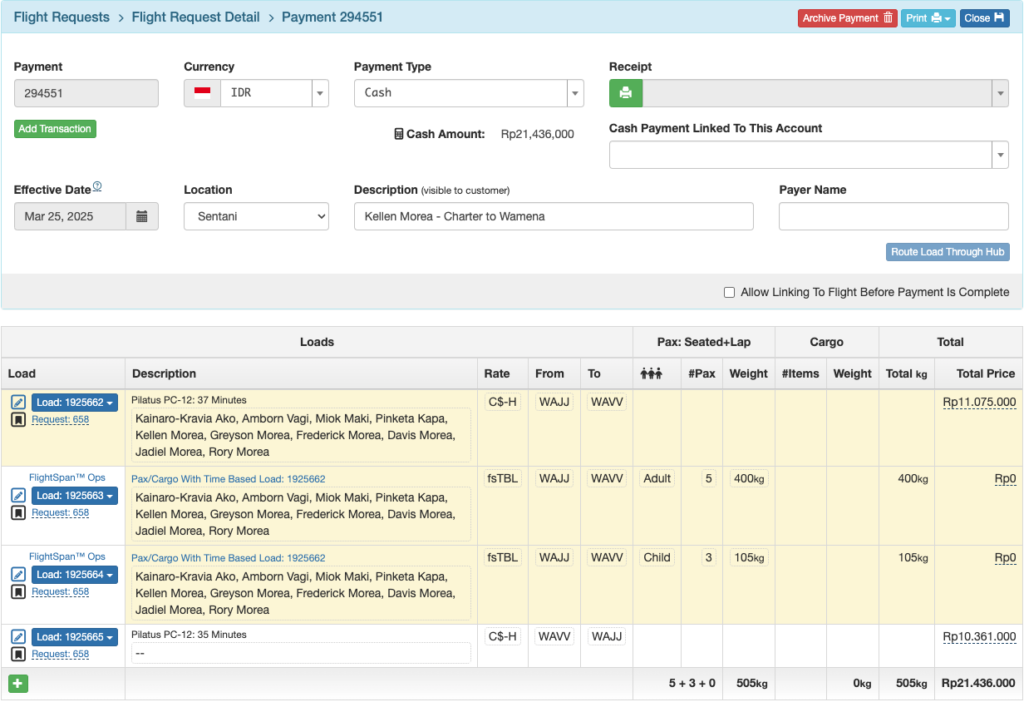
Decision Point
Is it a request for a charter or for a shared (e.g. seat rate, cost per kilo) flight?
If it’s a shared flight, the next step is to pay for their loading. Will the customer pay the balance in full, or put down a deposit and pay the rest later?
If a charter, will it be flown as booked, or may the routing change before flight?
Pay Cash Now
From the Flight Request form, click the Create Payment button.

The Payment Detail will open with the appropriate data prefilled.
Decision Point
If it’s a charter, will it be flown as booked, or may the routing change before flight?
If it’s a shared flight (e.g. seat rate or cost per kilogram), the next step is to pay for their loading. Will the customer pay the balance in full, or put down a deposit and pay the rest later?
Charter – As Booked
Decision Point
Will the customer pay the balance in full, or put down a deposit and pay the rest later?
Charter – Route May Change
When creating time-based (charter) loads, it may be necessary to edit the routing or the loading after a cash-type payment has been made. However, the expense for each leg is created separately, and if an attempt is made to edit each leg, you will end up with a remainder amount for each load that cannot be combined to complete the route, even if the total remaining balance is sufficient.
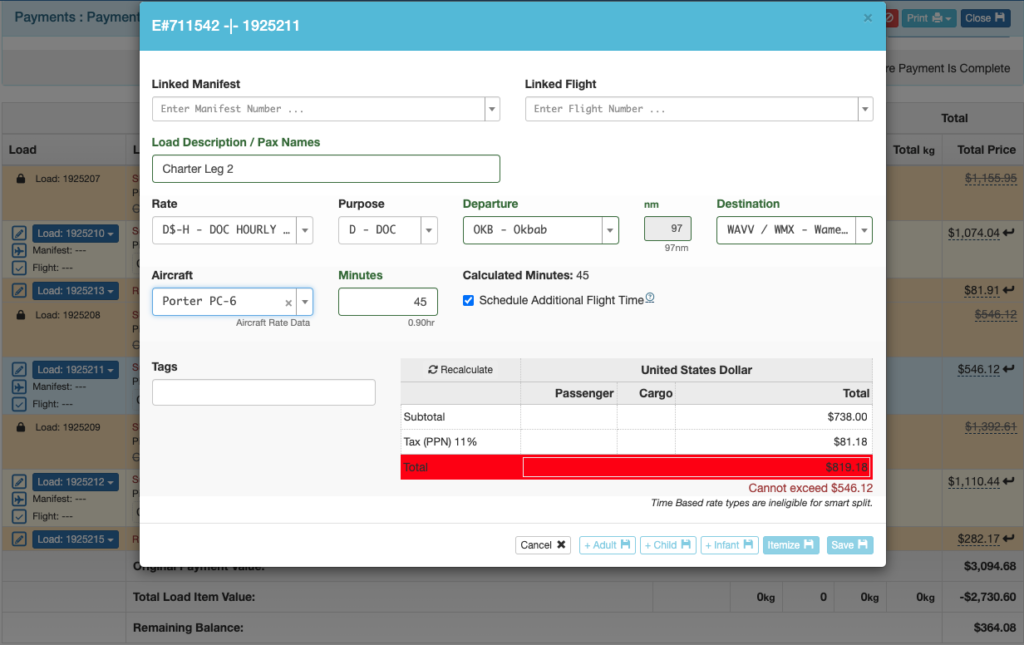
To address this issue, collapse the loads before printing the receipt by clicking on the load number and selecting Collapse Time Based Loads.

Note: When you click collapse, the separate loads will be combined into one load, with
- The description of the selected load retained, and with the routing added
- The total minutes combined
- The first departure point
- The last arrival point
- Total cost is recalculated, which may result in a slight difference in total due to company rounding settings
Decision Point
Will the customer pay the balance in full, or put down a deposit and pay the rest later?
Payment in Full
Accept payment and print the receipt by clicking either the green receipt button or by selecting Cash Receipt from the Print menu.

You will be asked to confirm payment in full. If it’s a time based load (charter) you will also be warned that you haven’t collapsed the loads.

Note that if it is rare to book a charter where the route may change after a cash payment is complete, you can switch off the collapse warning from Company Custom Settings.

Decision Point
Was this a charter that had the loads collapsed? Or was it any other type of request?
Deposit with Balance Paid Later
If the customer is paying a deposit now and will pay the rest later…..
[Content to be developed once the UI is complete]
Decision Point
Was this a charter that had the loads collapsed? Or was it any other type of request?
Any Other Request Type
Next click the green Schedule Payment button that appears at the top after printing the receipt, and the Scheduling Calendar will open with only this Payment displayed.

Drag the Payment onto the schedule at the desired date and time on the desired aircraft.
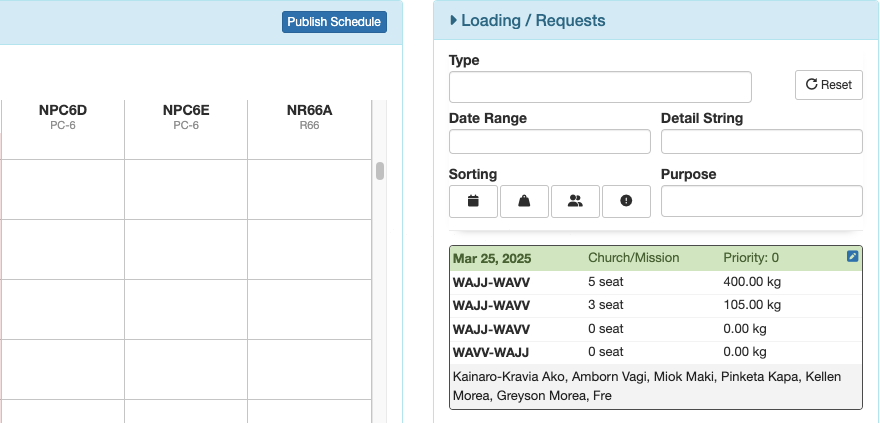
Decision Point
Will you be using a Manifest for the load?
Collapsed Charter
Do not schedule the Payment directly. Instead, click the Request link to return to the Flight Request.

Note: Scheduling the flight from the Payment instead of the Request will result in inconsistent scheduling. The scheduled legs will be correct only if there is loading on each leg of the charter.
Next click the green Schedule Request button at the top of the Flight Request, and the Scheduling Calendar will open with only this Request displayed.

Drag the Request onto the schedule at the desired date and time on the desired aircraft.
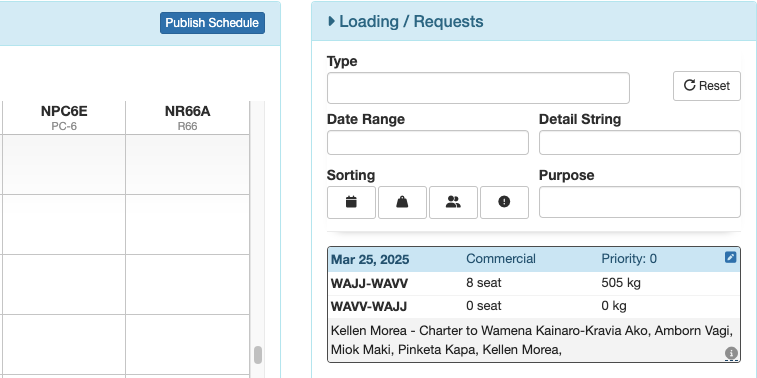
Decision Point
Will you be using a Manifest for the load?
Manifest
When you drag a completed Payment or a Flight Request with payment information, you will be offered the opportunity to create a manifest, or just the schedule.
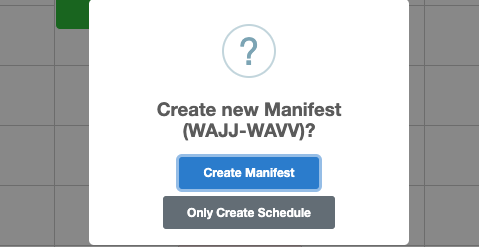
If you choose Create Manifest, a Manifest will be created and attached to the Schedule Detail with all the outbound loads.

If you chose Only Create Schedule, or if you have return loading that will be on a manifest, move the loading to a manifest using the Move this load to a Manifest button.

Note: An advantage of creating the manifest later is you have more control to ensure only the desired loading ends up on the correct manifest(s).
Next you will refine the flight schedule and change the schedule status.
No Manifest
When you drag a completed Payment or a Flight Request with payment information, you will be offered the opportunity to create a manifest, or just the schedule.

Choose Only Create Schedule, and the loads will be added to the Non-Manifest Loads section of the Schedule Detail.

Next you will refine the flight schedule and change the schedule status.
Change Schedule Status
Refine the flight schedule as required.
When planning is complete, change the schedule status to Planned or Confirmed to send notifications to passengers and crew, and to make the scheduled flight available on the iPad.

The booking is complete, and the pilot can execute the flight using FlightSpan™ on the EFB.
